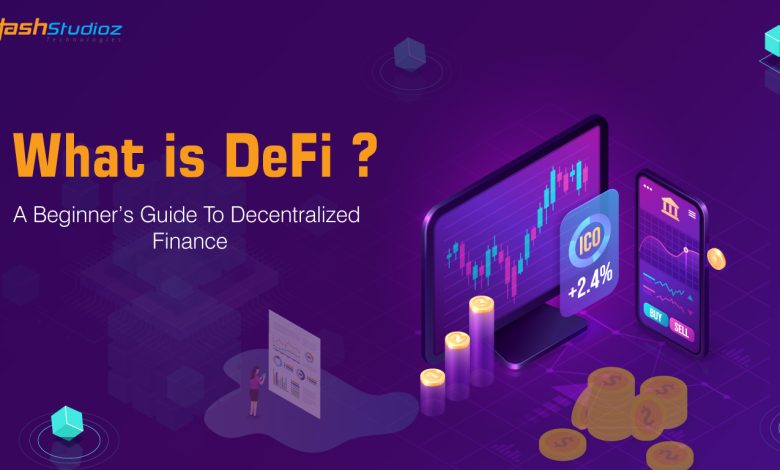Introduction to DeFi: What You Need to Know

- Understanding the Basics of DeFi
- Exploring the World of Decentralized Finance
- Key Concepts in DeFi Explained
- The Rise of DeFi: A Beginner’s Guide
- Navigating the Complexities of Decentralized Finance
- Getting Started with DeFi: Tips for Beginners
Understanding the Basics of DeFi
DeFi, short for Decentralized Finance, is a rapidly growing sector within the cryptocurrency industry. It refers to financial services that are built on blockchain technology, aiming to provide alternatives to traditional banking systems. Understanding the basics of DeFi is crucial for anyone looking to explore this innovative space.
One of the key features of DeFi is its decentralized nature, which means that there is no central authority controlling the system. Instead, transactions are executed through smart contracts, which are self-executing contracts with the terms of the agreement directly written into code. This eliminates the need for intermediaries, reducing costs and increasing efficiency.
Another important aspect of DeFi is its focus on interoperability. Different DeFi protocols can interact with each other, allowing users to access a wide range of financial services within the ecosystem. This interconnectedness is one of the reasons why DeFi has gained so much traction in recent years.
In addition to decentralized exchanges and lending platforms, DeFi also encompasses other services such as decentralized stablecoins, derivatives, and asset management. These innovative products offer users more control over their finances and the opportunity to earn passive income through activities like yield farming and liquidity provision.
Overall, DeFi represents a paradigm shift in the way we think about finance. By leveraging blockchain technology and smart contracts, it has the potential to democratize access to financial services and create a more inclusive global economy. As the DeFi ecosystem continues to evolve, it is essential to stay informed and educated about its principles and opportunities.
Exploring the World of Decentralized Finance
Decentralized Finance, or DeFi, is a rapidly growing sector within the cryptocurrency industry that aims to revolutionize traditional financial systems. Unlike centralized finance, which relies on intermediaries such as banks or brokers to facilitate transactions, DeFi operates on blockchain technology, allowing for peer-to-peer transactions without the need for a middleman.
One of the key features of DeFi is its emphasis on transparency and security. By utilizing smart contracts, which are self-executing contracts with the terms of the agreement directly written into code, DeFi platforms can ensure that transactions are secure and verifiable. This level of transparency helps to build trust among users and reduces the risk of fraud or manipulation.
Another important aspect of DeFi is its accessibility. Anyone with an internet connection can participate in DeFi, regardless of their location or financial status. This inclusivity has the potential to democratize finance and provide financial services to underserved populations around the world.
Furthermore, DeFi offers a wide range of financial products and services, including lending, borrowing, trading, and asset management. These services are typically more efficient and cost-effective than traditional financial institutions, making DeFi an attractive option for those looking to maximize their returns or access new investment opportunities.
Overall, exploring the world of DeFi can open up a wealth of possibilities for individuals seeking to take control of their finances and participate in a more open and transparent financial system. As the DeFi ecosystem continues to evolve and expand, it is important for users to stay informed and educated on the latest developments in order to make the most of this exciting new frontier in finance.
Key Concepts in DeFi Explained
Decentralized Finance, or DeFi, is a revolutionary concept that aims to transform traditional financial systems by leveraging blockchain technology. In DeFi, financial services are built on decentralized networks, allowing for greater accessibility, transparency, and security. Understanding key concepts in DeFi is essential for anyone looking to participate in this rapidly growing sector.
- Smart Contracts: Smart contracts are self-executing contracts with the terms of the agreement directly written into code. They enable automated transactions without the need for intermediaries.
- Liquidity Pools: Liquidity pools are pools of tokens locked in a smart contract that users can trade against. They provide liquidity for decentralized exchanges and allow users to earn fees by providing their assets.
- Decentralized Exchanges (DEXs): DEXs are platforms that facilitate peer-to-peer trading of cryptocurrencies without the need for a central authority. They offer greater privacy and control over assets compared to centralized exchanges.
- Yield Farming: Yield farming is the practice of staking or lending cryptocurrencies to earn rewards in the form of additional tokens. It involves providing liquidity to DeFi protocols in exchange for returns.
- Governance Tokens: Governance tokens are tokens that give holders voting rights to participate in the decision-making process of a decentralized protocol. They allow users to have a say in the future development of the platform.
By familiarizing yourself with these key concepts in DeFi, you can gain a better understanding of how decentralized finance works and how you can participate in this innovative ecosystem. Whether you are looking to trade cryptocurrencies, earn passive income, or contribute to the governance of DeFi protocols, having a solid grasp of these concepts is crucial for navigating the world of decentralized finance.
The Rise of DeFi: A Beginner’s Guide
Decentralized Finance, or DeFi, has been gaining significant traction in the world of cryptocurrency and blockchain technology. DeFi refers to a new financial system that operates without traditional intermediaries such as banks or financial institutions. Instead, DeFi relies on smart contracts and blockchain technology to provide financial services in a decentralized manner.
One of the key aspects of DeFi is its ability to offer a wide range of financial services, including lending, borrowing, trading, and more, all without the need for a central authority. This has led to a surge in the development of DeFi applications and platforms, offering users the opportunity to participate in a more open and accessible financial system.
One of the main drivers behind the rise of DeFi is the concept of yield farming, where users can earn rewards by providing liquidity to decentralized exchanges and other DeFi platforms. This has attracted a significant amount of capital into the DeFi space, leading to increased innovation and growth within the ecosystem.
As DeFi continues to evolve and expand, it is important for newcomers to understand the basics of this emerging technology. By familiarizing yourself with the fundamentals of DeFi, you can take advantage of the opportunities it presents and participate in this exciting new financial landscape.
Navigating the Complexities of Decentralized Finance
Navigating the complexities of decentralized finance can be a daunting task for newcomers to the world of DeFi. With the rapid growth of this innovative financial ecosystem, it is essential to understand the various components and intricacies involved.
One of the key aspects of DeFi is the use of smart contracts, which are self-executing contracts with the terms of the agreement directly written into code. These smart contracts enable decentralized applications (dApps) to operate without the need for intermediaries, providing users with greater control over their assets.
Another important factor to consider in DeFi is the concept of liquidity pools. These pools consist of funds locked in a smart contract that users can trade against, providing liquidity to decentralized exchanges. By contributing assets to these pools, users can earn fees in return, making it a popular way to generate passive income in the DeFi space.
Furthermore, decentralized lending and borrowing platforms play a significant role in the DeFi ecosystem. These platforms allow users to lend out their assets to earn interest or borrow assets by providing collateral. This peer-to-peer lending model eliminates the need for traditional financial institutions, offering users more flexibility and lower fees.
In addition to these components, decentralized exchanges (DEXs) are a crucial part of the DeFi landscape. DEXs allow users to trade cryptocurrencies directly with one another without the need for a centralized intermediary. This peer-to-peer trading model provides users with greater privacy, security, and control over their funds.
Overall, navigating the complexities of DeFi requires a solid understanding of smart contracts, liquidity pools, lending platforms, and decentralized exchanges. By familiarizing yourself with these key components, you can take full advantage of the opportunities that decentralized finance has to offer.
Getting Started with DeFi: Tips for Beginners
When starting with DeFi, it is essential for beginners to take some key tips into consideration to navigate this complex and rapidly evolving space. Here are some valuable insights to help you get started:
- Research: Before diving into DeFi, it is crucial to conduct thorough research to understand the basics of decentralized finance, including key concepts, platforms, and potential risks.
- Start Small: Begin by investing a small amount of capital to familiarize yourself with the DeFi ecosystem and minimize potential losses as you learn the ropes.
- Use Secure Wallets: Ensure that you use reputable and secure wallets to store your digital assets securely and protect them from potential hacks or theft.
- Diversify Investments: Spread your investments across different DeFi projects to reduce risk and maximize potential returns in this volatile market.
- Stay Informed: Stay up-to-date with the latest news, trends, and developments in the DeFi space to make informed decisions and adapt to changing market conditions.
By following these tips, beginners can build a solid foundation in DeFi and embark on their journey towards financial empowerment and innovation in the decentralized finance landscape.




